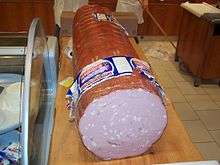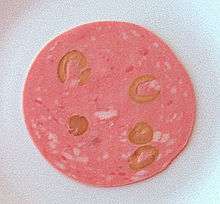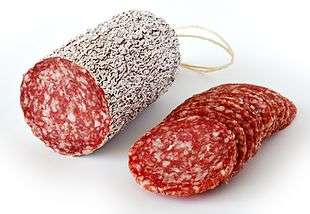Mortadella
Mortadella (Italian pronunciation: [mortaˈdɛlla]) is a large Italian sausage[1] or luncheon meat (salume [saˈluːme]) made of finely hashed or ground heat-cured pork, which incorporates at least 15% small cubes of pork fat (principally the hard fat from the neck of the pig). It is traditionally flavoured with black pepper grains, but modern versions can also contain pistachios or, more rarely, myrtle berries.


The best-known version of mortadella is Mortadella Bologna IGP, but other varieties are found across Italy, including some made of other meats.
Etymology
The origin of the name mortadella is debated. One theory derives the name from the Latin word mortarium (mortar), traditionally used to pound the meat to produce the sausage.[2][3] This theory, proposed by Giancarlo Susini, professor of ancient history in the University of Bologna, relies on two funerary steles kept in the Archaeological Museum of Bologna, believed to pertain to the same monument, one showing a herd of piglets and the other a mortar and pestle.[4] Another theory, introduced by Ovidio Montalbani in the 17th century, derives the name from a Roman sausage flavoured with myrtle berries that Romans called farcimen myrtatum or farcimen murtatum (myrtle sausage).[5][3] [2] Myrtle was in fact a popular spice before pepper became available to European markets.[5]
History
Traditionally, the pork filling was ground to a paste using a large mortar (mortaio [morˈtaːjo]) and pestle.
Mortadella originated in Bologna, the capital of Emilia-Romagna. Anna Del Conte (The Gastronomy of Italy 2001) found a sausage mentioned in a document of the official body of meat preservers in Bologna dated 1376 that may be mortadella.
Varieties
Mortadella Bologna has Protected Geographical Indication (IGP) status under European Union law, and is the best known world-wide. The zone of production is extensive: as well as Emilia-Romagna and the neighbouring regions of Piedmont, Lombardy, Veneto, Marche and Tuscany, it includes Lazio and Trentino.
Mortadella di Prato, produced in Tuscany, is also defined by an IGP. It is flavoured with pounded garlic and coloured with alchermes.
The mortadella of Amatrice, high in the Apennines of northern Lazio, is lightly smoked.
Mortadella di cavallo is made from horsemeat in Albano Laziale in Lazio.[6]
The American sausage called "bologna" is named after the mortadella of Bologna.
Similar products outside Italy
Lusitanic and Hispanic cultures

Mortadella is very popular in Spain and Portugal, where a variety with pepper and olives is widely consumed, especially in sandwiches. In eastern Spain, the standard mortadella is often referred to as mortadela italiana (Italian mortadella), to differentiate it from a local variant named catalana.
Mortadella is also very popular in Argentina, Bolivia, Peru, Brazil, Ecuador, Chile, Colombia, Uruguay and Venezuela, thanks to the Italian immigrants who settled in these countries in the early 20th century. In these countries it is spelled mortadela, and its recipe is quite similar to the traditional Italian, with additional pepper grains.
In Brazil, São Paulo has a very popular mortadela sandwich sold in the Mercado Municipal.
In Puerto Rico, "smoked mortadella" is sometimes confused with commercial salami, or with salami cotto, because cafeterias, panaderias, colmados, and restaurants buy the bulk of whole smoked mortadella. While salami may contain pork, beef, veal and small pieces of fat uniformly distributed within the sausage, mortadella has the traditional larger chunks not so uniformly distributed. Its diameter is much larger than that of hard salami and more closely resembles salami cotto (cooked) in size, hence the confusion of some people. It is smaller in diameter than the traditional mortadella de Bologna because the smoking process causes some shrinkage. It is best served at room temperature to bring out its rich flavour.
Central, Southern and Eastern Europe
In Romania, a similar cold cut is also known as parizer. It is a type of artisan bologna. In Hungary, a similar product is called, in Hungarian, mortadella and a plain variety called pariser, parizer or párizsi. The term parizer is also often used in Bosnia-Herzegovina, while parizier is used in other territories of the Balkans. The classic Italian mortadella is widely sold in supermarkets along the entire Adriatic coast.
In Greece, where there is a smaller version in addition to the regular one, that variety is called Parizaki or Mortadelaki, and in Bulgaria, Slovenia, Croatia, Serbia and North Macedonia, the product known as mortadela is widely eaten.
In Poland, mortadela slices are sometimes dipped in batter, fried and served with potatoes and salads as a quicker (and cheaper) alternative to traditional pork chops.
Middle East and North Africa
In several countries, such as Morocco, Algeria, Egypt, Iraq, Syria, Lebanon, Jordan, Palestine, United Arab Emirates, Qatar, Saudi Arabia, Kuwait and Israel, halal or kosher mortadella is sold, which is made from chicken, beef, or turkey. The Siniora brand, established in Jerusalem in 1920, is the first in the region, a mortadella with sliced olives, pistachios or pepper.[7] Lebanese Al-Taghziah is a famous brand that is sold around the world.[8] The most popular brands in the GCC are Americana Group and Halwani Brothers. It is also popular in Iran, albeit usually made with beef or lamb, and called commonly kaalbas, from Russian kolbasa.
Pork mortadella is sold in Egypt, Lebanon, Jordan, Syria, and the UAE.
United States
A similar commercial sausage product that omits the cubes of pork fat, called bologna, is popular in the United States. A variety that includes olives and pimentos is called olive loaf.
Mortadella is one of the three meats in Central Grocery's Muffaletta Sandwich in New Orleans, Louisiana, USA along with Holland ham and Genoa salami.[9]
Mortadella was banned from import into the United States from 1967 to 2000 due to an outbreak of African swine fever in Italy.[10] This ban was a pivotal part of the plot of the 1971 film La mortadella starring Sophia Loren. The title for the United States release was Lady Liberty.
The ban in the United States was lifted due to the Veterinary Equivalency Agreement that allowed countries to export products that had been shown to be disease-free as part of an overall agreement that would allow products deemed safe in the United States to be exported to the European Union.[11]
Russia and former Soviet Union
In Russia, Ukraine and other former Soviet states, a very similar product is called doktorskaya kolbasa (Russian: Докторская колбаса, lit. "doctor's sausage"). However, this product is normally made from mixture of beef and pork (sometimes beef and lamb or chicken for religious reasons), and does not include pieces of fat or myrtle; mortadella-style sausages with pieces of fat are called lubitelskaya and stolichnaya. Instead, it is flavoured with just coriander and nutmeg and also traditionally contains eggs and milk, which are usually absent in traditional mortadella. Unlike mortadella, doktorskaya kolbasa contains lower amounts of fat and is high in proteins.
The name "doctor's sausage" was coined in the Soviet Union in the 1930s to refer to sausages and meat products recommended by doctors to help with undernourishment and stomach problems. During the Soviet era, it was commonly advertised as being nutritious (due to its low fat content) and remained popular throughout former Soviet states to the present day. [12]
East Asia
Chả lụa or Vietnamese mortadella is sometimes used as an accompaniment to the Vietnamese dish bánh cuốn.[13]
References
- "Mortadella - Define Mortadella at Dictionary.com". Dictionary.com.
- Hazan, Marcella (2012). The Essentials of Classic Italian Cooking. Pan Macmillan. p. 17. ISBN 9780752228044.
- Davidson, Alan (2014). The Oxford Companion to Food. Oxford: OUP Oxford. p. 533. ISBN 9780191040726.
- Roversi, Giancarlo (2013). La Mortadella Bologna IGP. Storia di un mito (in Italian). Bologna: Consorzio mortadella Bologna.
- Roversi, Giancarlo (2013). La Mortadella Bologna IGP. Storia di un mito (in Italian). Bologna: Consorzio mortadella Bologna.
- "Farmer Jack — a Siniora Sons Inc. Company". farmerjack.ps. Retrieved 2016-02-11.
- "Al-Taghziah".
- "Best Muffulettas in the French Quarter and Nearby". FrenchQuarter.com.
- "The Return of Mortadella". The New York Times. 13 February 2000.
- "Bologna Journal; Coming to a Deli Near You: A Long-Taboo Sausage". The New York Times. 10 February 2000.
- "Russian Kitchen - Why the Soviets' favorite bologna was called "doctor's sausage"?". Russia Beyond the Headlines.
- "Stall 1006 - Banh Cuon - noodlepie". typepad.com.
External links
| Wikimedia Commons has media related to Mortadella. |
- Istituto per Valorizzazione dei Salumi: Mortadella (in Italian)
- Mortadella di Bologna (in Italian)
- Carlo Cantoni and Patrizia Cattaneo, "La mortadella: aspetti attuali tecnici della sua produzione" (in Italian)
- Clifford A. Wright, "Sausage Peddlers, Vagabonds, and Bandits: Part 1": types of Italian sausage
